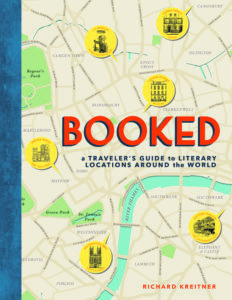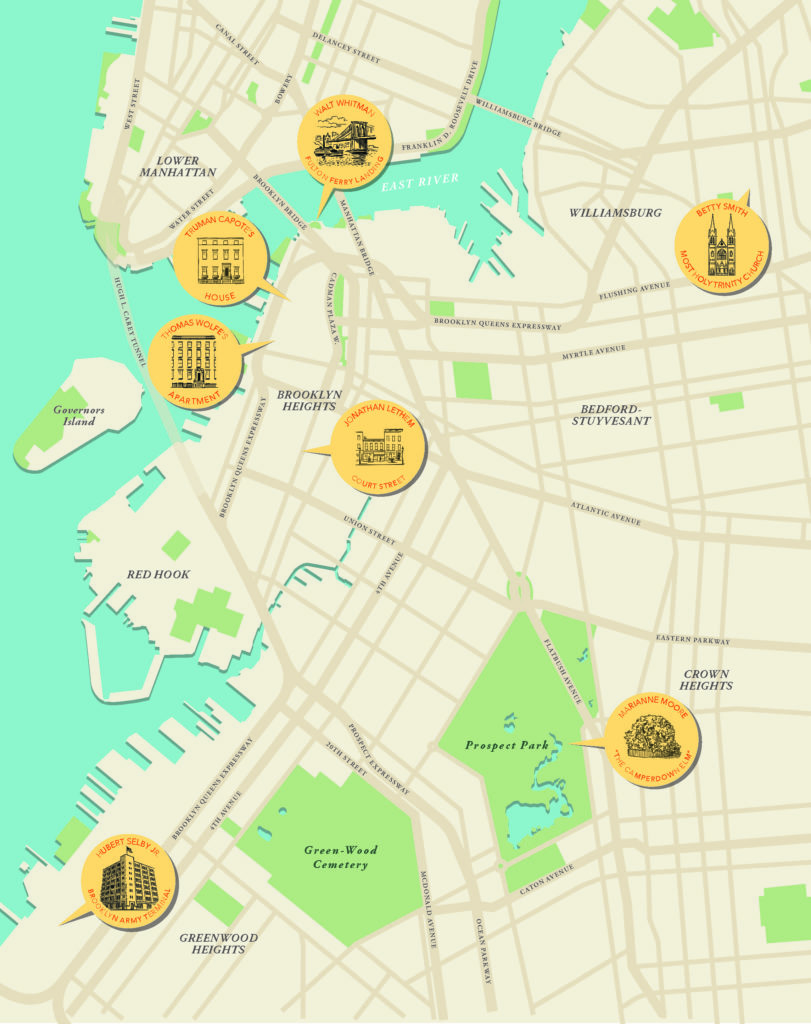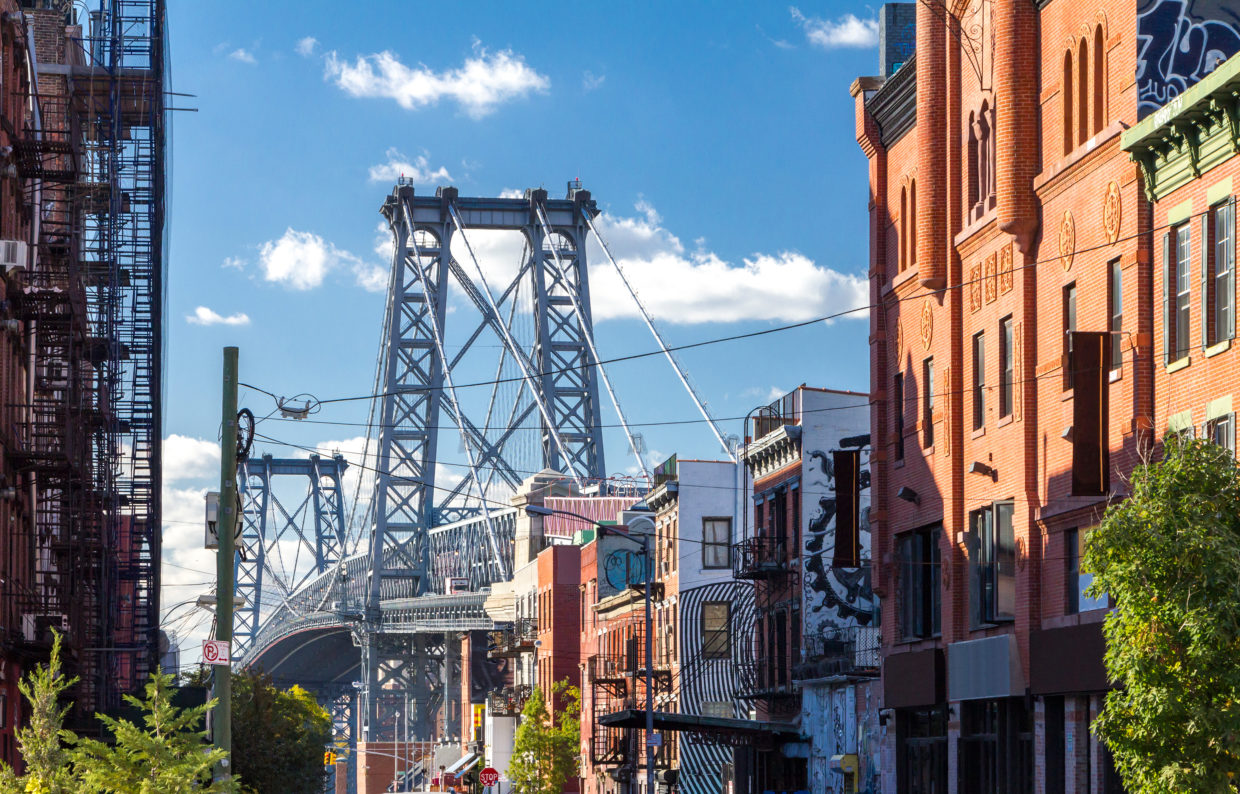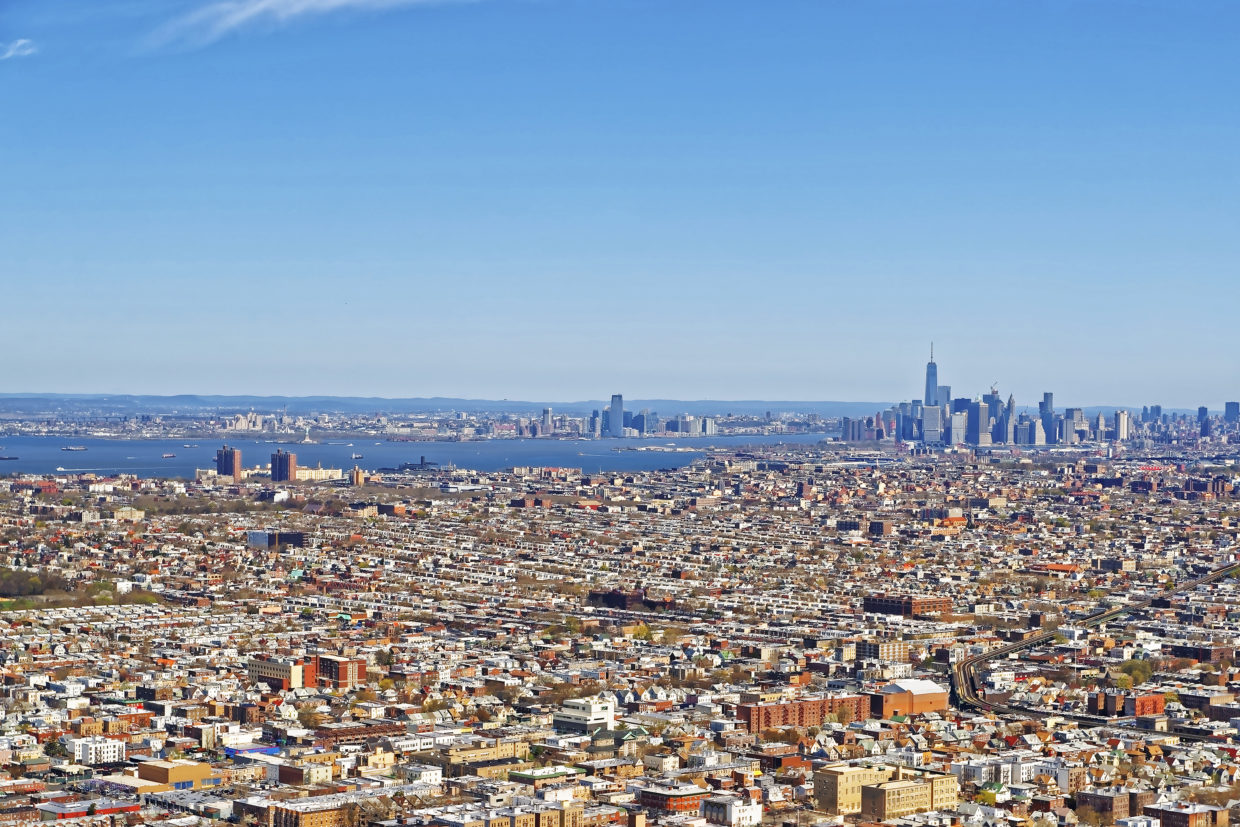
Trying to Get Beyond the Cliches of Literary Brooklyn
Richard Kreitner Visits the Stomping Grounds of Whitman, Moore, and Many Others
These days, no place on the globe is as much associated with the manufacture of literature as Brooklyn, New York, where this very book, in fact, was written. The clichés are all true: the hunched-over wannabe-novelist in every café, the insufferable (and unmissable) book-world parties. (One recent author went out of his way to mention on his book’s cover jacket that he didn’t live in the borough.) But there is also a lot more to literary Brooklyn than might first meets the eye; namely, the millions of non-writerly residents in the city’s most populous borough—too busy raising kids, working two or three jobs, trying to improve their families’ lives to worry about who got the latest six-figure advance and what the privileged editors of one prestigious journal said about those of another. What’s truly literary about Brooklyn isn’t the sheer density of writers and editors who live there but the sheer amount of lives being lived, from Canarsie to Bay Ridge, DUMBO to Bushwick, all the freaking time. “It’d take a guy a lifetime to know Brooklyn t’roo an’ t’roo,” says the narrator of Thomas Wolfe’s classic 1935 short story “Only the Dead Know Brooklyn.” “An’ even den, yuh wouldn’t know it all.” The same is true of Brooklyn-based literature. Here, however, is a start.
The godfather of Brooklyn letters, of course, is Walt Whitman. Born on Long Island, he lived in the then-independent city during the formative years of his adult life, when he worked as the editor of the Brooklyn Eagle, based on Fulton Street. Often, the journalist would end the day by walking down to the East River and boarding a ferry to Manhattan, where he spent his evenings drinking in bohemian Greenwich Village dive bars and carousing late into the night.
Whitman name-checked many Brooklyn places in his poetry and even more in his journalism, but perhaps the Kings County location most associated with the barbaric yawper isn’t in Brooklyn proper at all, but on that ferry between the Fulton slip and the Manhattan docks. In “Crossing Brooklyn Ferry,” a poem included in the first 1855 edition of Leaves of Grass and repeatedly altered in subsequent versions, Whitman expresses his love for the teeming cacophony on the boat, the faces and noises and smells. “Crowds of men and women attired in the usual costumes, how curious you are to me!” he sings. While many then bemoaned (as they do now) the sheer mass of humanity that had to be reckoned with on public transit, Whitman rejoiced in what it revealed about the interconnectedness of human beings and indeed all things. The experience of riding the ferry opened his mind to a sense of cosmic timelessness, the universality of experiences good and bad and neither and both: the ups and downs, the rushes of contradictory emotions, the triumphs and imperfections, the regrets and the hopes. These insights made him think that fifty or a hundred years later people would still be experiencing the same thing. In the poem he reaches out to Brooklynites of the future:
I am with you, you men and women of a generation, or ever so many generations hence,
Just as you feel when you look on the river and sky, so I felt,
Just as any of you is one of a living crowd, I was one of a crowd,
Just as you are refresh’d by the gladness of the river and the bright flow, I was refresh’d,
Just as you stand and lean on the rail, yet hurry with the swift current, I stood yet was hurried,
Just as you look on the numberless masts of ships and the thick-stemm’d pipes of steamboats, I look’d.
Of course, the East River is somewhat less clogged with steamboats these days—the technology that seemed so new and exciting in Whitman’s day has long since been superseded. Perhaps, then, nothing is quite as timeless as “Crossing Brooklyn Ferry” would have us believe. After all, within Whitman’s own lifetime—though after he had left Brooklyn, first for Washington and then for the bucolic pastures (seriously!) of Camden, New Jersey—the opening of the majestic Brooklyn Bridge rendered the old Fulton Ferry irrelevant literally overnight; after years of decline, it finally ceased operations in 1924.
I too lived, Brooklyn of ample hills was mine.
In recent years, however, ferries have once again begun braving the river’s tide-swelled waves. In 2011, the new East River Ferry began operating with seven stops in Brooklyn, Manhattan, and Queens, including a new dock at the foot of Fulton Street; within a few years the network expanded further to include seventeen piers. Once again riders can be among the living crowd, can be refreshed by the gladness of the river, can lean on the rail and be hurried along. Set up to abate crowding on the city’s subways and buses, the ferries have seen ridership levels soar far beyond official projections. (Oddly enough, the beards and mustaches on some passengers even add to the effect of traveling back in time.) Not far from the ferry slip in Brooklyn Bridge Park is an outpost of the Whitman-inspired ice-cream joint Ample Hills Creamery, with the immortal words from “Crossing Brooklyn Ferry” painted on the wall:
I TOO LIVED, BROOKLYN OF AMPLE HILLS WAS MINE.
WHERE TO VISIT
Fulton Ferry Landing
Brooklyn Bridge Park
334 Furman Street Brooklyn, NY 11201
Betty Smith’s A Tree Grows in Brooklyn (1943) is a coming-of-age tale largely set in the Nolan family’s tenements in East Williamsburg, in 1912. (They live first on Bogart Street, then Lorimer, and finally Grand.) 11-year-old Francie Nolan is a young girl born to poor parents. “There was no bathroom and the toilet was in the hall and shared by two families,” Smith writes of one apartment. She knew what she was talking about, having been born to a working-class family in the neighborhood in 1896.
The book is full of rich descriptions of Williamsburg, as when Francie and her brother, Neeley, run chores on Manhattan Avenue, “past Maujer, Ten Eyck, Stagg to Scholes Street. Beautiful names for ugly streets. From each side street hordes of little ragamuffins emerged to swell the main tide.” Many of the area’s tenements have since been replaced by public housing projects where young working-class children face the same difficulties the Nolan family had. Elsewhere in the book Francie attends mass at what she considers “the most beautiful church in Brooklyn . . . It was made of old gray stone and had twin spires that rose cleanly into the sky, high above the tallest tenements.” The church is likely the still-standing Most Holy Trinity Church, just a few blocks away at 138 Montrose Avenue, where Smith herself was baptized.
Near the end of the novel, Francie and Neeley are looking out on the town from their roof. “There’s no other place like it,” Francie says with wonder. “Like what?” Neeley asks. “Brooklyn!” Francie answers. “It’s a magic city and it isn’t real.”
WHERE TO VISIT
Most Holy Trinity Church
138 Montrose Avenue
Brooklyn, NY 11206
It might seem inevitable that the endless, leaf-lined streets of Brooklyn, dotted with well-preserved parks, would attract novelists, journalists, and poets. But Brooklyn wasn’t always so serene. In the mid-20th century, Truman Capote felt he had to explain why he had decided to take up residence in the benighted borough—first in a humble apartment in Clinton Hill and then in a majestic 1839 mansion in Brooklyn Heights.
The tree was neglected and at serious risk of dying. A gaping hole in its trunk had been shoddily filled with concrete and rats had taken up residence in its wood.
“I live in Brooklyn. By Choice,” Capote famously wrote in the opening sentence of “A House on the Heights,” a 1959 essay. “Those ignorant of its allures are entitled to wonder why. For, taken as a whole, it is an uninviting community . . . Yet, in the greenless grime-gray, oases do occur, splendid contradictions, hearty echoes of healthier days.” Brooklyn Heights was an example, with its “sea gull’s view of the Manhattan and Brooklyn bridges, of lower Manhattan’s tall dazzle and the ship-lane waters, breeding river to bay to ocean, that encircle and seethe past posturing Miss Liberty.” The house in which Capote kept his apartment sold a few years ago for $12 million.
WHERE TO VISIT
Truman Capote’s former house (private)
70 Willow Street
Brooklyn, NY 11201
In 1872, just a few years after Prospect Park opened to the public, a florist in the East New York neighborhood gifted the city a very special tree. It was a Camperdown Elm, one of the few in the world descended from the original of the species, which had been developed by an experimental arborist in Scotland some 40 years earlier. The tree cannot reproduce itself; its knobby limbs, drooping to the ground, need lots of support and sustenance to survive. When the Camperdown Elm was planted in Prospect Park, near the Boathouse, it was rooted on a little hillock so as to give the heavy, weeping arms a better chance of clearing the ground.
By the 1960s, the tree was neglected and at serious risk of dying. A gaping hole in its trunk had been shoddily filled with concrete and rats had taken up residence in its wood. Rescue came in a peculiarly literary form. In 1965, Marianne Moore, a longtime resident of Brooklyn (she lived for nearly 40 years at 260 Cumberland Street near Fort Greene Park), was elected president of the Greensward Foundation, a public advocacy group set up to support New York’s neglected parks. She became fascinated by the tree and what its helplessness signified about the interconnectedness of all living things (note the Whitman connection). In 1967, at almost 80 years old, she wrote a poem, “The Camperdown Elm,” about what would be required to save the endangered tree:
Props are needed and tree-food. It is still leafing;
still there. Mortal though. We must save it. It is
our crowning curio.
Save it the city did. Moore’s poem, which was published in the New Yorker, sparked a public campaign to buttress the tree with wooden crutches and a complicated array of cables and rods that help keep it alive today, along with a low black fence that keeps the public away. A century and a half later it is still leafing, still there. In 2017, a restaurant opened just a few blocks away, in Park Slope, named for the aged arboreal survivor.
WHERE TO VISIT
Camperdown Elm
Near the Prospect Park Boathouse
101 East Drive
Brooklyn, NY 11225
After his groundbreaking first novel Look Homeward, Angel, set in his hometown of Asheville, North Carolina, was published to rave reviews in 1929, Thomas Wolfe became one of the most famous writers in America. Fans sent him letters by the satchel and even tracked him down, while the Manhattan literati feted him as the next big thing. Wolfe didn’t enjoy the adulation, however; he felt alienated from the New York literary scene, even a little intimidated. After a ten-month trip to Europe, he wanted to find a place he could settle down to write and reconnect with the down-to-earth “real” America he had known while growing up.
The massive, boisterous writer worked, fueled by mud-black coffee and cigarettes lit one after the other, while standing half-naked in front of an open window, using as his desk the door of an old refrigerator.
He decided to rent a room in “the quaint old town of Brooklyn.” It was just far enough from Manhattan to give him much-needed isolation, but still close enough to Maxwell Perkins, the editor he relied on to give his work form. “You couldn’t find a better place to work,” he wrote to the secretary of the Guggenheim Foundation, which had given him a grant to work on his widely anticipated second novel.
In early 1931, Wolfe moved into a ground-floor apartment at 70 Verandah Place near Cobble Hill Park. The rent cost $65 per month. There the massive, boisterous writer worked day and night, fueled by mud-black coffee and cigarettes lit one after the other, all while standing half-naked in front of an open window, using as his desk the door of an old refrigerator. Passersby on the sidewalk across the street often stopped and stared.
Wolfe frequently went on walks at night, through Red Hook and around downtown and over the Brooklyn Bridge, “to escape the suffocation of his apartment and of his own mind,” as Evan Hughes writes in his fascinating 2011 book, Literary Brooklyn. Sometimes his ambles would take him down to the Gowanus Canal, which Wolfe famously described, eighty years before its designation as a Superfund site, as a “huge symphonic stink,” containing traces not only “of a stagnant sewer, but also the smells of melted glue, burned rubber, and smoldering rags . . . deceased, decaying cats, old tomatoes, rotten cabbage, and prehistoric eggs.”
Toward the end of 1931, Wolfe moved to more spacious quarters in nearby Columbia Heights, before finally settling in at 5 Montague Terrace, in a building that has a plaque commemorating his residency. After the exhaustive, nerve-racking editing process with Perkins led to the nearly thousand-page Of Time and the River, Wolfe sat for an interview with the New York Herald Tribune. The profile unkindly revealed the slovenliness of his rooms and even listed the actual address. Wolfe saw that it was time to leave. “I have lived here long enough and finished a big job here,” he wrote, “and it’s time to go.” He decamped again for Europe, where he soon got the news he needed: The new novel was a hit.
Three years later, the man many thought the most promising writer of his generation—“the only contemporary writer who can be mentioned in the same breath as Dickens and Dostoevsky,” the critic Malcolm Cowley declared—was dead at 37. You Can’t Go Home Again, his unfinished novel about his time in Brooklyn, was published posthumously, in 1940.
WHERE TO VISIT
Thomas Wolfe’s longest-lasting apartment in Brooklyn (private)
5 Montague Terrace
Brooklyn, NY 11201
Alfred Kazin was just one of many 20th-century Brooklyn Jews who made what another, Norman Podhoretz, famously called “one of the longest journeys in the world”—from a Brooklyn ghetto to the heights of literary renown in Manhattan—and became one of the leading literary critics in America. Kazin wrote about his journey in a trilogy of riveting memoirs: A Walker in the City (1951), Starting Out in the Thirties (1965), and New York Jew (1978).
He grew up in a four-bedroom flat in a small brick house at 256 Sutter Avenue. Unlike much else in Brownsville from those bygone times—like the buildings where my own grandparents grew up and the corner luncheonette my great-grandfather ran as a sort of community hall—Kazin’s home still stands. Brownsville in the 1920s was 95 percent Jewish, and known as the “Jerusalem of America.” Kazin compared it to a Polish or Russian shtetl. Brownsville was the “margin of the city,” Kazin recalled, even “the end of the world.” All around was “dead land, neither country nor city, with that look of prairie waste I have so often seen on my walks along the fringes of American cities near the freight yards,” he remembered in Walker. He often went for walks among the tall trees in Highland Park and around the Ridgewood Reservoir, since decommissioned and filled in by a peaceful meadow.
“Every time I go back to Brownsville,” Kazin wrote, “it is as if I had never been away. From the moment I step off the train at Rockaway Avenue and smell the leak out of the men’s room, then the pickles from the stand just below the subway steps, an instant rage comes over me, mixed with dread and some unexpected tenderness. It is over ten years since I left to live in ‘the city’—everything just out of Brownsville was always ‘the city.’ Actually I did not go very far; it was enough that I could leave Brownsville. Yet as I walk those familiarly choked streets at dusk and see the old women sitting in front of the tenements, past and present become each other’s faces;”—Whitman again!—“I am back where I began.”
WHERE TO VISIT
Alfred Kazin’s childhood home (private)
256 Sutter Avenue
Brooklyn, NY 11212
In Brown Girl, Brownstones (1959), Paule Marshall’s semi-autobiographical novel about immigrants from Barbados who live in Brooklyn, the main character, ten-year-old Selina Boyce, is a young girl caught in the middle of her parents’ dysfunctional marriage. She is confused about growing up. Her family rents a brownstone in Bedford-Stuyvesant that her mother badly wants to buy; her father, on the other hand, wants to move back to Barbados. The conflict roils the family and ultimately causes it to break apart.
Near the Bed-Stuy brownstone is a green space Selina particularly adores. “Chauncey Street languished in the afternoon heat, and across from it Fulton Park rose in a cool green wall,” Marshall writes. “After the house, Selina loved the park. The thick trees, the grass—shrill-green in the sun—the statue of Robert Fulton and the pavilion where the lovers met and murmured at night formed, for her, the perfect boundary for her world; the park was the fitting buffer between Chauncey Street’s gentility and Fulton Street’s raucousness.”
The book’s frank depiction of prostitution, violence, drugs, homosexuality, and cross-dressing made Last Exit a scandalous book.
Notable not only for its strong female voice and the perspective of an immigrant class not often depicted in American fiction, Brown Girl was well-reviewed on publication, but fell out of print for years until the Feminist Press republished it in the early 1980s. A specific address for the Boyce family’s brownstone is not given in the book, but in her 2009 memoir Triangular Road—named for the connections between Africa, Barbados, and Brooklyn that defined her life—Marshall mentions that she grew up at 501 Hancock Street, just a few blocks from Fulton Park. Bedford-Stuyvesant, Marshall said in an interview, was “the place that had the greatest impression on me.”
WHERE TO VISIT
Fulton Park
70 Chauncey Street
Brooklyn, NY 11233
Bay Ridge native Hubert Selby Jr. is known for two exceptional Brooklyn-based novels. His best-known book, thanks to Darren Aronofsky’s 2000 film version, is Requiem for a Dream (1978), set largely in Brighton Beach and Coney Island, which concerns the descent of four people into addiction, incarceration, and psychosis.
More evocative of its time and place, however, is Last Exit to Brooklyn (1964), set on the South Brooklyn waterfront in present-day Sunset Park and Bay Ridge, around the area of Third Avenue near the Brooklyn Army Terminal. This shocking book contains six connected stories about the seedy side of life in 1950s Brooklyn among the poor underclass left behind by deindustrialization and white (middle-class) flight.
Told in an idiosyncratic, conversational style without conventional punctuation, the book’s frank depiction of prostitution, violence, drugs, homosexuality, and cross-dressing made Last Exit a scandalous book when it was published by Barney Rosset’s Grove Press, an imprint that made something of a specialty of pushing the bounds of decency. Allen Ginsberg, who had faced his own obscenity trial, as Selby did in England, predicted that Last Exit would “explode like a rusty hellish bombshell over America and still be eagerly read in a hundred years.”
Though it retains a few admirers and champions, the book has fallen somewhat out of fashion in recent years, and the gritty dockside neighborhood it depicted has been cleaned up considerably, especially as actual shipping and manufacturing have been replaced on the waterfront by “makerspaces” and expensive condos. But Selby’s work is a must-read for a glimpse not only of Brooklyn in its worst days but of the indomitable spirit that prevailed in the borough even then. Despite their flaws, Selby’s street-tough characters continue to strive for better. The neighborhood itself becomes the enemy, the embodiment of an uncaring, brutalizing world that beats them down and defeats them, but perhaps not completely.
WHERE TO VISIT
Brooklyn Army Terminal
140 58th Street
Brooklyn, NY 11220
Jonathan Lethem’s fifth novel, Motherless Brooklyn (1999), put his native borough back on the literary map. Lionel Essrog, a private investigator with Tourette’s syndrome, works for the owner of a local detective agency who is murdered. With his obsessive, detail-fixated mind, Lionel is determined to figure out why.
The book is largely set in the area of Court Street, the commercial strip that heads south from Borough Hall. The street, Lethem writes, is reminiscent of “the old Brooklyn, a placid ageless surface alive underneath with talk, with deals and casual insults, a neighborhood political machine with pizzeria and butchershop bosses and unwritten rules everywhere.” It’s a world unto itself, vastly different even from Smith Street, just one block away. “Court Street, where it passed through Carroll Gardens and Cobble Hill, was the only Brooklyn, really,” Lethem has one of his characters think. The rest of Brooklyn, “everything east of the Gowanus Canal . . . apart from small outposts of civilization in Park Slope and Windsor Terrace, was an unspeakable barbarian tumult.”
Lethem’s next book, The Fortress of Solitude (2003), followed up with an equally evocative description of Dean Street in the Boerum Hill neighborhood in the late 1970s, on the cusp of gentrification. After years of living on Dean Street, where he was raised, Lethem later decamped for southern California. “Brooklyn is repulsive with novelists, it’s cancerous with novelists,” Lethem told the Los Angeles Times. “That can sometimes be too much.”
WHERE TO VISIT
Court Street
Brooklyn, NY 11201
__________________________________

Excerpted from Booked: A Traveler’s Guide to Literary Locations Around the World. Used with permission of Black Dog & Leventhal. Copyright © 2019 by Richard Kreitner.
Richard Kreitner
Richard Kreitner is the author of Break It Up: Secession, Division, and the Secret History of America’s Imperfect Union and Booked: A Traveler’s Guide to Literary Locations Around the World. He has written for The New York Times, The Washington Post, The Boston Globe, The Nation, Slate, Raritan, The Baffler, Jewish Currents, and other publications. He lives in Beacon, New York.
















